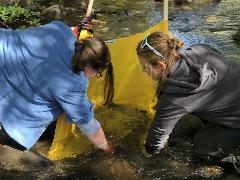Samantha Briggs, IWLA Clean Water Program Director
Outdoor America 2020 Issue 3
Through the evolution of Save Our Streams from 1969 to 2020, two things are very apparent: we have an immensely dedicated group of volunteers, and not all is well with water quality today.
If you click through sites on the Clean Water Hub, you’ll see some sites that boast very good water quality, but, without a clear catastrophic cause, there are also a slew of sites that are fair or even poor. The catastrophic cause – a massive oil spill or burning rivers – that captures public attention has been replaced with less visible threats that are just as dangerous. The most serious risk today is polluted runoff. This is pollution from many diffuse sources including oil from pavement and parking lots and fertilizer from tens of millions of acres of farm fields and suburban lawns. Yet the country (save some amazing Ikes and volunteers) does not seem compelled to change these practices. Why is that?
The problem comes down to the human brain. As much as humans have changed over thousands of years (from living in caves to skyscrapers), our primal brains (responsible for survival, drive and instinct) have not much evolved. Our ancestors were concerned with immediate and dire perils, the occurrences that were affecting their welfare in that moment such as predators or lack of food. Their goal was simply to stay alive, and that is our goal as well.
The catastrophic cause – a massive oil spill or burning rivers – that captures public attention has been replaced with less visible threats that are just as dangerous.
Therefore, disastrous events such as fires, hurricanes or terrorist attacks garner so much more news coverage than other hazards. They create a strong emotional reaction, which propels our population into action; promoting planning, reasoning and preparedness for the next catastrophe. Threats that attack us slowly, such as degrading water quality or climate change, do not evoke that same response for whole populations. However, these threats are equally harmful when half of the streams monitored do not meet basic safety standards and cancer-causing nitrate in drinking water is becoming more concentrated in locations across the country. These slow warnings will still result in our demise, and the demise of our children or grandchildren, even without commanding the latest news cycle.
In a world where catastrophes claim the news coverage, Ikes and other Save Our Streams volunteers still fight to protect our soil, air, woods, waters and wildlife. We don’t live in denial about the health of our environment and we recognize the long-term complications. But, even so, if we are going to rally our communities to fight these world-changing environmental hazards, here are some tips to help draw in those who don’t necessarily understand the endangerment that they can’t see.

- Community Science – get everyone involved. Community science, such as Save Our Streams water quality monitoring, connects individuals more deeply to their environment and helps communities understand less visible environmental risks such as polluted runoff. Engage more new monitors and encourage them to share their monitoring data on the Clean Water Hub. Chemical monitoring is easy to do and requires no training. Find out how to get involved.
- Reframe the threat for different audiences. The impact of pollution in our waterways affects everyone, but in different ways. While you may love to fish, others will strictly care about the safety of drinking water or their pocketbook. Get to know who you are trying to reach and discuss the issue accordingly. To learn more about water quality issues, check out the Clean Water Webinars. Additionally, the IWLA blog has a wealth of information.
- Use teachable moments. Utilizing pollution events, such as when an Iowa grocery store dumped 800 gallons of milk into a storm drain, is a great way to enlighten your community about other problems for water quality. “So, you think the milk is bad, let me tell you about road salt!” Encourage them to visit the Clean Water Hub to learn about water quality in their community.
- Be persistent! Because non-point-source pollution doesn’t necessarily always fall in the realm of newsworthy, you will not get everyone’s attention with just one touch. Keep repeating and rewording your message to the same audience, engage them on matters they care about, and soon you will have more people behind you. If you need assistance with your message, League staff can help. Email sos@iwla.org and we will get back to you.
By using community science and communicating perils early, often, and in different ways, we may just be able to overcome the consequences of ignoring water pollution and climate change. The work we do for the League will impact many generations.
Find out how to get your community involved in Save Our Streams and other community science